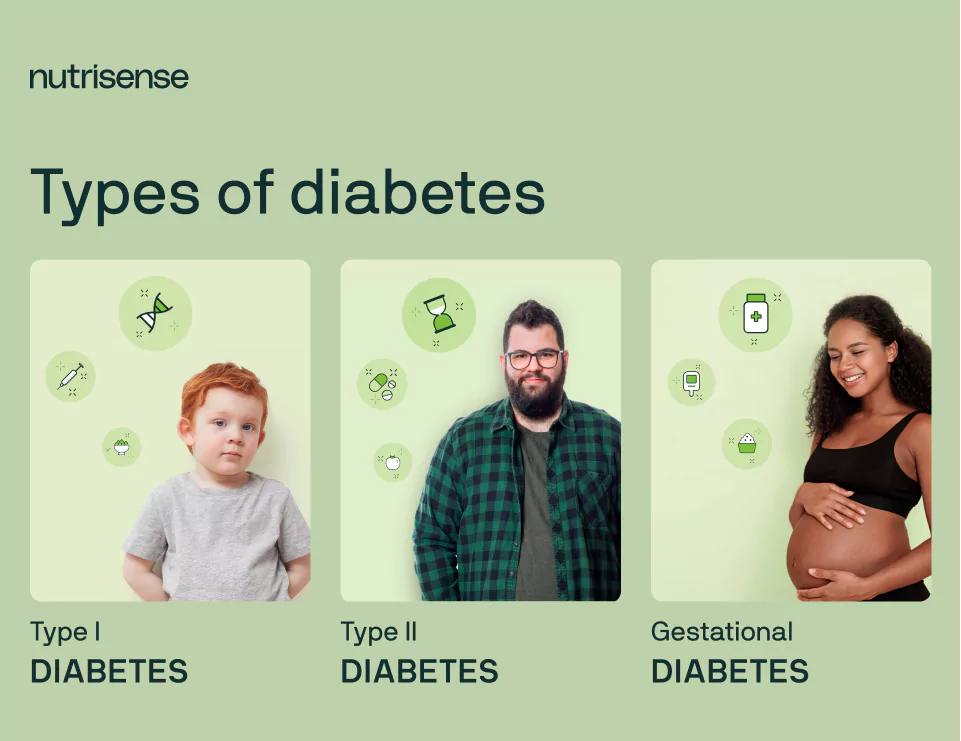Prediabetes—Causes, Symptoms, and Prevention

Key Takeways
Diabetes is a common chronic condition that is on the rise. While not all cases of diabetes can be prevented, some types start with prediabetes and may be preventable or reversible.
Prediabetes occurs when your glucose levels are higher than normal but not yet high enough to be considered diabetic levels. However, eventually these higher glucose levels may lead to diabetes. It can feel like a wake-up call, but it doesn’t have to be a diagnosis. The good news is that prediabetes can be reversible for some people.
It's no secret that healthy lifestyles help ensure a healthy mind and body and prevent several chronic ailments, conditions, and diseases. That's why learning the basics of healthy eating and physical exercise, maintaining healthy weight goals and sleep patterns, and focusing on a low-stress life are all important to support healthy blood sugar.
Here's a little more about prediabetes and how you can introduce healthy lifestyle changes to combat it.
When Your Doctor Says "Prediabetes"
You leave your annual check-up with the word “prediabetes” echoing in your mind. Your latest lab work showed a fasting glucose of 112 mg/dL, and you feel a familiar sense of frustration.
You’ve been trying so hard to make smart choices, but the numbers are still creeping up. The advice to simply “eat better” feels like a guessing game you keep losing, and you’re ready for a clear plan that shows you what’s actually working for your body.
What Is Prediabetes And Is It Reversible?
Prediabetes means your fasting glucose sits in a gray zone, usually between 100–125 mg/dL. Not normal, but not yet diabetes. It’s your body’s early signal that something’s shifting.
Common symptoms
Prediabetes symptoms include things like increased appetite, mood swings, fatigue, frequent urination, and blurred vision.
There are three types of diabetes: type 1, type 2, and gestational diabetes. Here’s a little more about each one:

Type 1 Diabetes
- It usually develops early in life.
- It’s an autoimmune disorder impacting the insulin-producing cells of your pancreas.
- It’s characterized by inadequate insulin production, resulting in an inability to convert your food into usable energy for your cells.
- This type of diabetes usually requires insulin injections and may also be hereditary.
Type 2 Diabetes
- It often develops later in life.
- It can be attributed to a variety of risk factors such as diet, lifestyle, and medical history.
- It may be mild (controlled by lifestyle or medication) or severe (requiring insulin injections).
- Type 2 diabetes occurs when your body is no longer sensitive to insulin. Even though you may continue to make insulin, your body may have difficulty using it to turn food into energy.
Gestational Diabetes
- It develops during pregnancy and typically resolves after childbirth.
- For some, it does not resolve and may instead develop into type 2 diabetes later on.
- Symptom-wise, gestational diabetes looks similar to type 2 diabetes.
11 Ways to Reduce the Risk of Prediabetes
Now that you know you can reduce your risk of prediabetes and diabetes, it's time to learn how. Making healthy diet and lifestyle choices is the first step! Remember: It's best to consult a healthcare professional before making any major changes.
Here are 11 tips and tricks to help you get started.
1) Work with a qualified nutrition expert

Making healthier food choices can go a long way in reducing your risk for prediabetes and diabetes. One of the most important ways to reduce your risk is to customize a healthier dietary approach for your unique body. You can learn how to do this with the help of a personal dietitian.
The role of your personal dietitian is to provide you with the tools and guidance to reduce your risk factors. They help guide the specific changes needed to achieve your goals and help you build a practical, actionable plan tailored to you. And most importantly, it’s tailored to fit your individual needs. These days, you can work just as effectively with an online nutritionist, as long as you find a credible, trustworthy one!
Tips and Resources
- Follow your doctor’s recommendations for regular blood glucose lab work and assessment.
- If you’ve been told you’re at risk of prediabetes (or already have prediabetes) use that information as data, not doom. Your body’s giving you feedback you can work with.
- Consider working one-on-one with a registered dietitian at Nutrisense who can help you track your glucose levels. Together, you’ll gain deeper insight into how your current approach may impact those levels. Your doctor can access your tracked data to follow along!
2) Focus on weight loss if you need to

Not everyone who has prediabetes or diabetes will be overweight. However, studies show that weight-loss interventions for those who may be overweight can also improve insulin sensitivity and glucose regulation.
Some research even suggests that losing body fat and adopting an exercise routine to reduce fat tissue can significantly improve glucose levels.
Tips and Resources
- Focus on a balanced diet that is rich in whole foods.
- Combine a healthy diet with regular, appropriate physical activity.
- Try to reduce your intake of refined grains (white flour, white rice, white bread) and added sugars.
- Consider reducing your intake of alcohol.
3) Eat fewer simple, processed carbs
One helpful way to decide which types of carbs to consume is to use the glycemic index (GI). The GI is a value assigned to different foods based on how quickly they raise glucose levels.
Foods with a low GI release glucose slowly into the blood, whereas foods with a high GI release glucose rapidly, causing a rapid rise in glucose levels. The GI of foods usually ranges from 0 to 70, but some high-GI foods can rank higher on the scale.
Refined carbs and sugars are digested faster than other foods, and because of their high GI, they tend to raise glucose levels. A low glycemic diet may improve glucose regulation, promote weight loss, and reduce cholesterol levels in some people.
Of course, the amount of a given food also matters. Glycemic load takes into account the amount of a food alongside its glycemic index and is the most practical way to apply the glycemic index.
Tips and Resources
- Consider fruits with a low glycemic index, such as apples, berries, oranges, lemons, limes, and grapefruit. Pair these with protein and eat your protein first for a better glucose response.
- Add more non-starchy vegetables, such as broccoli, cauliflower, summer squash, spinach, and green beans, to your diet.
- Instead of refined grains/flours, eat more whole grains like quinoa, brown rice, buckwheat, and oats.
- Introduce legumes such as lentils, black beans, and chickpeas into your diet.
- Avoid excessive amounts of white bread, rice, cereals, pasta, baked goods, and sugar-sweetened beverages.
4) Balance your diet

A healthy diet can help support normal glucose levels, and research indicates it may even help reverse prediabetes. While a 'healthy diet' can differ from person to person, it usually consists of balanced macronutrients and micronutrients customized for individual needs, high-quality calories, and adequate fiber.
There are multiple diets that may help support balanced glucose levels if you're prediabetic. The most common one is a lower-carbohydrate diet, which emphasizes adequate protein, healthy fats, fiber, and non-starchy vegetables, with additional low-glycemic-index carbs in smaller amounts.
A Mediterranean diet may also help prevent prediabetes, as research shows it’s effective for weight loss, which we know can improve glucose levels.
Tips and Resources
- Eat a varied macronutrient diet that best suits your body's individualized needs and supports balanced glucose levels
- The type of fat you eat is important. Focus on healthy fats like avocado, olive oil, nuts, seeds, and fatty fish.
- Consume high-quality meat such as grass-fed beef, wild-caught fish, and free-range poultry. Try to reduce or avoid cured or processed meats.
- Eat a good amount of fiber every day (25 to 30 grams).
5) Reduce foods that cause glucose imbalances
Sweetened beverages contribute to rising glucose levels in your bloodstream, which can be risky for people who already have prediabetes.
Other factors contributing to glucose spikes include added sugars and refined carbohydrates. For better glucose management, try the tips below.
Tips and Resources
- Reduce or avoid refined carbohydrates like white bread, pasta, noodles, pizza, white rice, and other foods made with white flour.
- Don't eat too many foods with added sugars, like candy, cakes, cookies, and pies.
- Sugar-sweetened beverages can also affect glucose levels. Avoid overconsuming soft drinks/soda, sports drinks, sweetened iced tea, energy drinks, and fruit juice/punch.
The American Heart Association recommends no more than 100 calories per day (about six teaspoons or 24 grams) for most adult women and no more than 150 calories per day (about nine teaspoons or 36 grams of sugar) for most men.
However, some people may notice that smaller amounts of added sugar, especially if eaten alone, may still cause glucose spikes. Practicing meal sequencing can be a helpful trick here.
6) Improve your overall hydration levels

Dehydration can negatively affect glucose levels in several ways. It is also essential to stay well-hydrated to prevent high blood glucose levels.
Tips and Resources
- Ensure you’re properly hydrated.
- Try not to exercise when it's too hot outside or under direct sunlight, especially if you have heat intolerance.
- If you're prone to dehydration, add more water to your diet with broths, fruits, and other water-rich foods.
7) Make exercising a regular part of your life
Appropriate amounts of exercise help to improve your physical health and can also boost mental health. There are many ways that exercise can support balanced glucose levels, specifically, including improving insulin sensitivity.
Tips and Resources
- Consult with your doctor and healthcare team before beginning an exercise program.
- Consider working with a dietitian trained in sports nutrition for an expert eye in how to support your body’s fitness goals.
- Start off gradually. You can gradually increase the duration and intensity of workouts, according to individual tolerance.
- Wondering what you can begin with? Try walking, biking, hiking, swimming, or dancing.
8) Find ways to reduce stress

High levels of stress on a consistent basis may also contribute to the development of prediabetes.
Tips and Resources
- Aim for quality relaxation and sleep every night and consult with a healthcare professional if you have insomnia.
- Practice relaxing activities like breathing techniques, walking in the park, yoga, and meditation.
- Ensure you are meeting your nutritional needs. Nutrient imbalances are stressors for your body; including ingesting too much or too little of a given nutrient for your unique needs.
- Evaluate your social relationships and seek out connections that support your self-care priorities.
9) Embrace health technology
If you have been diagnosed with prediabetes, you may feel extra motivation to track your daily glucose fluctuations and responses. Today's technology helps us do so with devices that monitor glucose levels, such as continuous glucose monitors or glucose biosensors.
Tips and Resources
- A continuous glucose monitor (CGM) or glucose biosensor is a device that measures glucose levels 24/7 by sensing glucose in interstitial fluid.
- A finger-stick glucometer is a device that can be used by taking a small drop of blood with a lancet and placing it on the test strip. This helps you see a “snapshot” of your glucose levels at the moment.
Using health technology with a holistic health program like Nutrisense can help take it that extra mile, with the support you need to understand your data.
"It really gives me that extra piece of support that is helping me manage my prediabetes."
— Christy Pavillard, Nutrisense member
Find the right Nutrisense programto turn insight into progress.
Prediabetes is a signal. Nutrisense helps you respond to it.
Prediabetes is a signal. Nutrisense helps you respond to it.
10) Work with your doctor

Your doctor and diabetes specialist can help you go through all the steps you need to understand prediabetes and track glucose levels.
Working with your doctor is essential, but you can also take daily steps between appointments to better understand and support your glucose control. Prediabetes and diabetes can occur alongside other metabolic changes, including alterations in cholesterol, blood pressure, triglycerides, and other inflammatory markers. So, it's good to have a medical professional supervise these regularly.
Tips and Resources
- Proactively ask your doctor for a prediabetes screening, then follow up with questions about how often you should have it.
- Even if you don't have prediabetes, ask your doctor whether you have any risk factors and what steps you can take to lower the risk of prediabetes.
11) Consider your eating window
When you eat later in the day, you can have higher overnight glucose values due to reduced insulin sensitivity in the evening. This may negatively affect fasting glucose readings the following morning, a marker of prediabetes and diabetes risk.
Research shows that earlier eating windows may benefit glucose regulation and insulin sensitivity.
Tips and Resources
- Reduce your alcohol intake, especially late at night.
- Use a continuous glucose monitor to see how your body responds to different types of food at various times of day, to determine the optimal time to stop eating.
- If you cannot eat earlier, try to make dinner the lightest meal of your day.
- Work with a dietitian to find an eating schedule that works best for your specific body.
Prediabetes and Nutrisense FAQ
Q1. Does insurance cover dietitian video calls, and how do they fit my prediabetes plan?
A1. Nutrisense offers video calls with registered dietitians that are often covered by insurance. You can check eligibility at no cost and schedule sessions to review your data, set simple experiments, and tailor meals, movement, and timing to your needs. These calls complement your doctor's care. The Nutrisense program does not diagnose, cure, or treat any condition.
Source: Nutritionist video calls
Q2. How long does each sensor last, and how are shipments scheduled?
A2. Members receive two glucose biosensors per month. Sensor duration depends on the sensor you use with the program. For example, each Stelo Glucose Biosensor lasts 15 days once activated, allowing you to collect continuous data throughout the month. Billing and shipping occur on the same day each cycle. If you need flexibility, you can pause your account or adjust shipments by contacting support.
Source: CGM plans
Q3. Can I bring my own CGM and still use the Nutrisense App?
A3. Yes. The Bring Your Own Sensor plan lets you connect a compatible CGM and use the Nutrisense App for logging, analytics, and insights. You can add coaching for personalized guidance. This option suits people who already have a sensor through a clinic or pharmacy.
Source: Bring your own sensor
Q4. What should I track alongside CGM data if I am focused on prediabetes?
A4. Pair glucose trends with logs on meals, ingredients, portion sizes, timing, activity, sleep, and stress. Note medications and labs your doctor orders, such as A1C. Review patterns in your Nutrisense app and during dietitian sessions to decide on small experiments and next steps for your plan.
Source: You have been diagnosed with prediabetes: now what?
Monitor and manage prediabetes with Nutrisense
Your glucose tells a story about how your body responds to life: the meals you eat, the sleep you get, the stress you carry. Learning to read it can change everything. That’s why stable levels are an important factor in supporting overall well-being. But viewing glucose isn't enough. With Nutrisense, you’ll learn how to use your body's data to make informed lifestyle choices that support healthy living.
1:1 guidance that fits your day
Sign up to access insurance-covered video calls with a glucose expert: a personal registered dietitian or certified nutritionist who will help tailor your lifestyle and diet to your goals.
Monitor and measure what matters
With the Nutrisense Program options, you can monitor your glucose with health tech like glucose biosensors and continuous glucose monitor (CGM)s, and analyze the trends over time with the Nutrisense App. This will help you make the most informed choices about the foods you consume and their impact on your health.
Get started
Ready to take the first step? Start with our quiz to find the right Nutrisense program to help you take control.
Go Beyond Glucose Data with Nutrisense
Your glucose can significantly impact how your body feels and functions. That’s why stable levels are an important factor in supporting overall wellbeing. But viewing glucose isn't enough. Nutrisense, you’ll be able to learn how to use your body's data to make informed lifestyle choices that support healthy living.
One-to-one coaching
Sign up to access insurance-covered video calls to work with a glucose expert: a personal registered dietitian or certified nutritionist who will help tailor your lifestyle and diet to your goals.
Monitor and measure what matters
With the Nutrisense CGM Program, you can monitor your glucose with health tech like glucose biosensors and continuous glucose monitor (CGM)s, and analyze the trends over time with the Nutrisense App. This will help you make the most informed choices about the foods you consume and their impact on your health.
Find your best fit
Ready to take the first step? Start with our quiz to find the right Nutrisense program to help you take control.

Kara Collier is a registered dietitian nutritionist and certified nutrition support clinician who is passionate about reshaping how we approach prevention, behavior change, and metabolic health. A Forbes 30 Under 30 honoree, she’s helped over 150,000 people improve their metabolic health using tools like continuous glucose monitors and behavior-focused nutrition strategies. Kara has been featured by Forbes, UC Berkeley, and HLTH, and has appeared on top podcasts like Mind Pump and The Genius Life.
